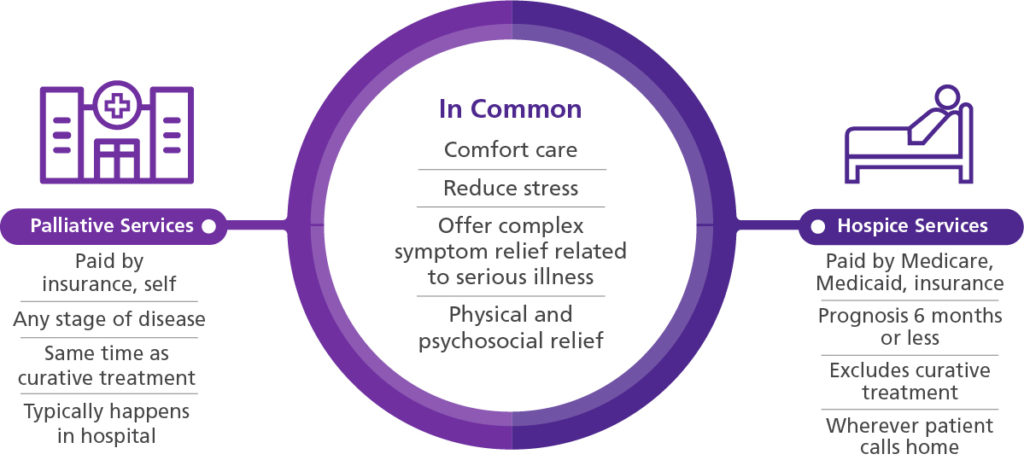Palliative Care and Hospice Care are two terms that are distinctly different and often misunderstood. Let’s break down what they mean and the care involved with each. While the objective of both hospice and palliative care is pain and symptom relief, the prognosis and goals of care tend to be different.
Palliative Care Services
This information from NIH National Institute on Aging provides helpful information about Palliative Care. https://www.nia.nih.gov/health/what-are-palliative-care-and-hospice-care
What is palliative care?
Palliative care is specialized medical care for people living with a serious illness, such as cancer or heart failure. Patients in palliative care may receive medical care for their symptoms, or palliative care, along with treatment intended to cure their serious illness. Palliative care is meant to enhance a person’s current care by focusing on quality of life for them and their family.
Who can benefit from palliative care?
Palliative care is a resource for anyone living with a serious illness, such as heart failure, chronic obstructive pulmonary disease, cancer, dementia, Parkinson’s disease, and many others. Palliative care can be helpful at any stage of illness and is best provided soon after a person is diagnosed.
In addition to improving quality of life and helping with symptoms, palliative care can help patients understand their choices for medical treatment. The organized services available through palliative care may be helpful to any older person having a lot of general discomfort and disability very late in life.
Who makes up the palliative care team?
A palliative care team is made up of multiple different professionals that work with the patient, family, and the patient’s other doctors to provide medical, social, emotional, and practical support. The team is comprised of palliative care specialist doctors and nurses, and includes others such as social workers, nutritionists, and chaplains. A person’s team may vary based on their needs and level of care. To begin palliative care, a person’s health care provider may refer him or her to a palliative care specialist. If he or she doesn’t suggest it, the person can ask a health care provider for a referral.
Where is palliative care provided?
Palliative care can be provided in hospitals, nursing homes, outpatient palliative care clinics and certain other specialized clinics, or at home. Medicare, Medicaid, and insurance policies may cover palliative care. Veterans may be eligible for palliative care through the Department of Veterans Affairs. Private health insurance might pay for some services. Health insurance providers can answer questions about what they will cover.
Visit the National Hospice and Palliative Care Organization website to find palliative care near you.

Hospice Care Services
From a personal experience, hospice care providers are angels on earth 👼🏻 For my parents’ generation, hospice meant a “death sentence”, as the services were provided only when you had less than a year to live.
The non-profit hospice providers I’ve encountered over the years have been terrific. When you’re researching providers keep an eye out for the non-profit providers.
Hospice care today is for a terminally ill person who’s expected to have six months or less to live. But hospice care can be provided for as long as the person’s doctor and hospice care team certify that the condition remains life-limiting.
What is hospice care?
Increasingly, people are choosing hospice care at the end of life. Hospice care focuses on the care, comfort, and quality of life of a person with a serious illness who is approaching the end of life.
At some point, it may not be possible to cure a serious illness, or a patient may choose not to undergo certain treatments. Hospice is designed for this situation. The patient beginning hospice care understands that his or her illness is not responding to medical attempts to cure it or to slow the disease’s progress.
Like palliative care, hospice provides comprehensive comfort care as well as support for the family, but, in hospice, attempts to cure the person’s illness are stopped. Hospice is provided for a person with a terminal illness whose doctor believes he or she has six months or less to live if the illness runs its natural course.
It’s important for a patient to discuss hospice care options with their doctor. Sometimes, people don’t begin hospice care soon enough to take full advantage of the help it offers. Perhaps they wait too long to begin hospice and they are too close to death. Or, some people are not eligible for hospice care soon enough to receive its full benefit. Starting hospice early may be able to provide months of meaningful care and quality time with loved ones.
Where is hospice care provided and who provides it?
Hospice is an approach to care, so it is not tied to a specific place. It can be offered in two types of settings — at home or in a facility such as a nursing home, hospital, or even in a separate hospice center.
Read more about where end-of-life care can be provided.
Hospice care brings together a team of people with special skills — among them nurses, doctors, social workers, spiritual advisors, and trained volunteers. Everyone works together with the person who is dying, the caregiver, and/or the family to provide the medical, emotional, and spiritual support needed.
A member of the hospice team visits regularly, and someone is usually always available by phone — 24 hours a day, seven days a week. Hospice may be covered by Medicare and other insurance companies. Check to see if insurance will cover the person’s particular situation.
It is important to remember that stopping treatment aimed at curing an illness does not mean discontinuing all treatment. A good example is an older person with cancer. If the doctor determines that the cancer is not responding to chemotherapy and the patient chooses to enter into hospice care, then the chemotherapy will stop. Other medical care may continue as long as it is helpful.

Summary
When a doctor certifies that someone is not expected to live longer than six months, Medicare offers hospice care. Hospice focuses on treating symptoms, not curing an illness.
Medicare has defined four levels of care to be sure everyone’s needs are met.
- Routine care provides pain relief and other treatments and therapies where you live.
- Continuous home care provides more intensive nursing care in your home in times of crisis.
- Inpatient care allows you to go to a hospital or other inpatient facility if you need round-the-clock care to treat severe symptoms.
- Respite care allows you to be treated in an inpatient facility for a few days to give your caregivers a chance to rest.
Your doctor and the other members of your hospice team work together to decide which level of care you need.
Final Thoughts
Take it from me, having conversations about your wishes and the wishes of your loved ones is a big relief when the time comes (even when they don’t want to talk about it 💗 Knowing what they want makes it so much easier to act knowing you are honoring those you love. And, relaying what you want to others is important too!
If you’d like to discuss how best to approach this topic for you and yours, pop me a note: Lynn@thelivingplanner.com.
If you’d like general information, my website is: https://thelivingplanner.com and my online courses/resources will give you an idea of what I offer to assist people, pets and businesses on this website: https://courses.thelivingplanner.com
One of my favorite planning quotes is by John F Kennedy, “The time to repair the roof is when the sun is shining.” Have a great week — Lynn
#LifeHacks #CareForPeopleCareForBusiness
